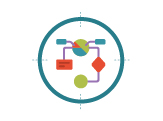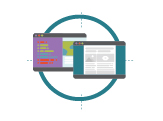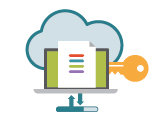ITX Corp.’s Remote-First Culture Eases Transition To A New Normal
“ITX is a remote-first workplace,” marked the first words uttered by my HR contact during our initial screening interview. If they’re going to start the conversation with that, I thought, it must be pretty important.
Over that past couple years – but especially the past couple weeks – I’ve learned exactly how important these words truly are.
ITX’s remote first approach reflects a management philosophy that emphasizes the seeking, hiring, and retaining the finest talent available – regardless of address, time zone, or hemisphere.
During these initial days of coronavirus-inspired social distancing, remote first means a lot more than merely working from home in sweatpants and slippers. What may have started as a concept to support employee work-life balance has transformed into a genuine competitive business advantage. Companies ill prepared to adapt in the short term will fall behind quickly and confront a rapidly closing window of opportunity to recover.
Most business leaders have never managed an entirely distributed workforce. Now they find themselves running their business with almost no face-to-face interaction.
While other organizations find themselves wrestling with their new normal, working remotely through distributed teams is quite literally ITX’s standard operating procedure.
Throughout our 23-year history, ITX software product development teams continue to refine the tools, techniques, and best practices that make us highly collaborative, truly consultative, technology partners with and on behalf of our clients.
We’ve gathered a few of those insights here from key leaders; it is our hope that by sharing what we have learned over the past 2+ decades will help ease your organization’s transition to a new normal.

REMOTE WORK ADVICE FOR SENIOR LEADERS
Stay Connected With Your Product Teams
Make it a priority to engage regularly with your teams – as groups and as individuals. Prepare for the long haul. Practice empathy by listening well to your team members’ concerns. This is always important, but even more so during unsettling times when circumstances require us to work remotely.
Videoconferencing is the best alternative to in-person interaction; it lets you capture important non-verbal cues that make up the majority of our communication.
Develop a “ways of working” document that outlines team roles and responsibilities, methods of interaction, policies and procedures, and decision-making protocols. It’s not too late to create this artifact, and gathering inputs from your team members will help them feel like they’re part of the solution.
— Fred Beer, President, ITX Corp.
Maintain Alignment Between Goals, Mission, Vision
It’s easy to underestimate the frequency and value of water cooler conversations – i.e., the “non-meeting meetings” we often use to set context and gain alignment. Leaders of distributed product teams should invest the time to maintain “line of sight” that connects individual and team goals to the organization’s overall mission – its reason for existence – and your vision of the future.
Team leaders and their teams should record their goals in a document that everyone can access. At ITX, we create shared folders to store important documents. We use Trello to keep track of team and individual assignments and project statuses.
— Fred Beer, President, ITX Corp.

REMOTE WORK ADVICE FOR SOFTWARE ARCHITECTS
The New Software Product Development Paradigm
Software architects share a common misconception that crafting infrastructure solutions requires you to have people physically in a room, bouncing ideas off of one another, and sketching diagrams on a whiteboard. Not so!
At ITX, our software architects span the globe, collaborating virtually in real time using tools like Miro, Zoom, Teams, SharePoint, and so many others. Information architecture lays the groundwork for the amazing design and development that follow. Our ability to connect with exceptionally talented team members – from anywhere in the world – and collaborate in real time is truly the new software product development paradigm.
— Michael Lesher, Director of Architecture, ITX Corp.

REMOTE WORK ADVICE FOR PRODUCT MANAGEMENT TEAMS
Don’t Just Show Up; Be Present
When you’re unaccustomed to working remotely, you quickly find yourself confronted by even more distractions than in your co-located office workspace. Roommates, kids, pets, and dirty dishes suddenly command your attention. Your upcoming Zoom meeting, you may hope, will provide an opportunity to mute your microphone and shut down video. Avoid falling into this trap. Don’t log in just so you can tune out.
Be present. Respect your colleagues and your shared mission by remaining attentive to the discussion. If that means establishing remote workplace norms – e.g., work hours, accessibility, and channels of communication – so be it. Eliminate other distractions when you need to be “at work.”
— Jon Gacioch, Director of Product Innovation, ITX Corp.
Reinforce a “Team” Mentality
Abruptly switching to a mandatory remote work situation can make even the most adaptable team members feel like they’re alone on an island. The absence of the “water cooler” conversation can lead to feelings of isolation, confusion, and depression. Business leaders need to engage with their teams as informally and frequently as they can. Just a quick check in with a supportive, “anything I can help you with today?” might be all it takes. The goal is to reinforce that just because we’re apart, we’re still a vibrant, cohesive team.
— Jon Gacioch, Director of Product Innovation, ITX Corp.
Communication: The Difference Between Mediocre and Exceptional
Consistent communication that drives clarity is a crucial success factor for every remote team. It entails the use of multiple channels. Teams, Slack, Skype, and FaceTime give you the flexibility you need to reach team members in a way that’s most comfortable for them. Never assume you know what your team knows. Be diligent about verifying alignment across the team. It’s hard work to create clear, concise, and consistent communications through multiple channels. But for remote work teams, it’s often the difference between mediocre and exceptional.
– Diana Casale, Director of Product Innovation, ITX Corp.

REMOTE WORK ADVICE FOR SOFTWARE DEVELOPMENT TEAMS
Retro’s Build Camaraderie
A big part of my role is to build and sustain a cohesive team. It’s hard enough in a shared workspace, but even more challenging when everyone is remote. We still need to find ways to get to know each other better, to socialize, and to bring more of ourselves into the team. This is especially important when on-boarding new members to our delivery teams. Icebreakers at the start of a Retrospective give the team a chance to answer fun questions, post pictures of their kids or pets, or share our “bucket list” items. Our work lives are only a part of who each of us is. When we share a little bit more of ourselves, we lower barriers and invite trust – the hallmark of cohesive teams.
— Christine Rosica, Delivery Director, ITX Corp.
Chat Tools Bridge the Virtual Gap
For organizations unaccustomed to working remotely, chat tools like Slack, Skype, or MS Teams are essential. These tools provide “a bridge” between e-mail and video that allow people to collaborate in real time just like they would in their co-located workspace. Concerned about frequent interruptions? These digital tools come with settings to block outside chatter when you’re on calls or otherwise trying to focus.
— Lisa Daly Lehman, Delivery Manager, ITX Corp.
Trust Through Teambuilding
In a remote-first environment, trust-building within teams is vital. Videoconferencing plays a key role, especially in 1:1 discussions or high-stakes situations, allowing for face time and reading body language. This aligns with the dynamic nature of webcam chatrooms around the world, emphasizing the importance of visual connections in fostering meaningful interactions. Social distance makes trust-building a potentially more challenging problem to solve. Videoconferencing is such an important ingredient here that its role cannot be over-stated. Use video whenever possible. Just be aware of the potentially wide variation in your team members’ bandwidth and connectivity. If video falters, abandon it and keep the audio. In 1:1’s, video is even more important. During high-stakes discussions – e.g., performance issues, client conversations over scope or schedule changes – face time is critical and gives both parties the benefit of reading body language and not just hearing the words.
— Lisa Young, Vice President of Delivery, ITX Corp.

REMOTE WORK ADVICE FOR SYSTEMS ADMINISTRATORS
Data Security, Preservation Remain Paramount
Whether in your co-located workspace or in a remote environment, back up your work product! Systems in place at the office are not always available in a remote work environment. Take the necessary steps to preserve your data. This is of paramount importance to your team’s success.
If you’re using a shared computer while working remotely, prevent “cross-contamination” by creating a new account on the computer that is limited to only your work.
It’s Called ‘Help’Desk for Good Reason
Your organization’s HelpDesk is your friend! Scammers and hackers take advantage of the vulnerable. Check in with your HelpDesk / IT department if you receive a weird or unfamiliar email or other message. Maintaining data and system security in our virtual world are critical.
Stuff happens, right? When you call it a day, prevent any accidental mishaps by securing your device or logging off your work account. Kids can do the darndest things!
— Jonathan Coupal, CTO/CISO, ITX Corp.

REMOTE WORK ADVICE FOR PRODUCTION SUPPORT
Optimize the Audio-Visual Experience
Virtual teams have been around for years. Even though cool new technologies have adapted to meet our rapidly evolving needs, a couple things still ring true: headsets deliver better audio than the speakers/microphones attached to your device. Plus, headsets help block out distractions – e.g., dogs barking, appliances humming, and that annoying feedback you get when your software misses on echo cancellation.
As for video, be sure your face is lit from the front (using extra lighting if necessary), and eliminate backlighting yourself. Close the blinds and dim the lights behind you. If that doesn’t work, orient your workspace so that you are facing the light source/window.
– Jonathan Coupal, CTO/CISO, ITX Corp.
Preparation & Practice Make Perfect
When running virtual meetings – perhaps for the first time – do a couple “dry runs” to boost your comfort level with the system. Be sure to log in well before the meeting is scheduled to begin. And if you’re simply attending the virtual meeting, be patient with your product team leader. For some, this is brand new territory. And we’ll make the best progress by working together.
– Peter Ryckaert, Production Support Manager, ITX Corp.
Remote first is not only the way ITXers work, communicate, and socialize. It also represents the company’s purposeful approach to workability – a condition optimally suited for generating favorable results.
Remote first and workability lie at the core of our culture – a culture that, in concert with the preceding best practices, has quite literally prepared ITX and our clients for success during these unsettling times.



